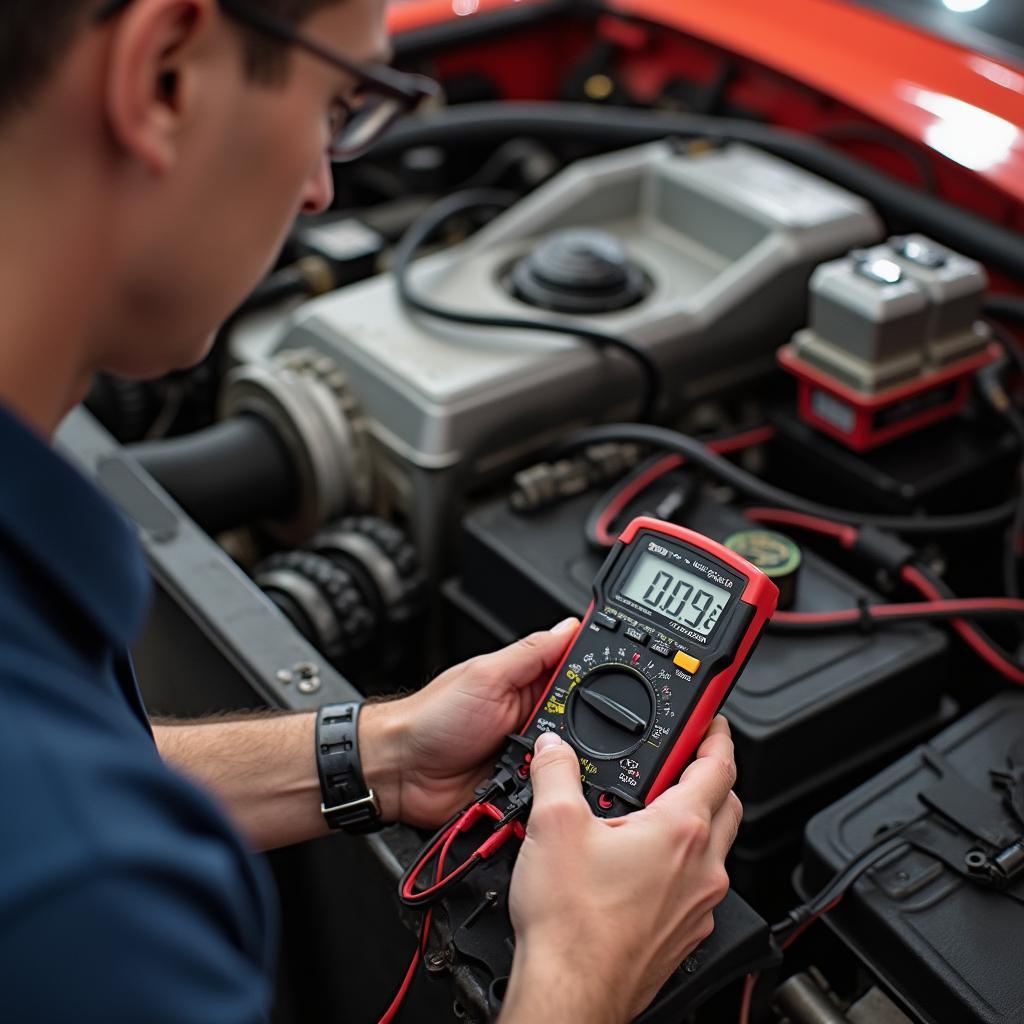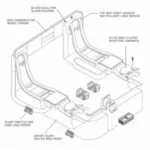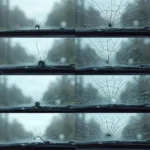Classic cars, with their vintage charm and mechanical beauty, offer a unique driving experience. However, their aging electrical systems can present a unique set of challenges. Whether you’re a seasoned enthusiast or a new classic car owner, understanding the intricacies of classic car electrical repairs is essential for keeping your prized possession running smoothly. This comprehensive guide delves into the world of classic car electrical systems, providing you with the knowledge to diagnose and potentially address common issues.
Understanding the Basics of Classic Car Electrical Systems
Unlike modern vehicles with their complex computer-controlled systems, classic car electrical systems are relatively simple. They operate on a basic 12-volt DC system, with the battery serving as the heart, supplying power to various components. Understanding the key components and their functions is crucial:
- Battery: The battery stores electrical energy and supplies it to the starter motor and other electrical components.
- Alternator: Driven by the engine, the alternator generates electricity to recharge the battery and power the electrical system while the engine is running.
- Starter Motor: This powerful electric motor cranks the engine, allowing it to start.
- Ignition System: Responsible for generating the spark that ignites the air-fuel mixture in the cylinders.
- Lighting System: Includes headlights, taillights, turn signals, and interior lights, ensuring visibility and safety.
- Gauges and Instruments: These provide the driver with essential information about the engine’s performance and other vehicle parameters.
- Wiring Harness: A network of wires and connectors that distribute power and signals throughout the vehicle.
Common Classic Car Electrical Problems and Troubleshooting Tips
Classic car electrical systems, due to age and exposure to the elements, are prone to a range of issues. Here are some common problems and troubleshooting tips:
1. Starting Problems
- Symptom: Engine cranks slowly or not at all.
- Possible Causes: Weak battery, corroded battery terminals, faulty starter motor, or ignition switch problems.
- Troubleshooting:
- Check battery voltage and clean terminals.
- Inspect starter motor connections for corrosion or damage.
- Test the ignition switch for proper operation.
2. Dim or Flickering Lights
- Symptom: Headlights, taillights, or interior lights are dim or flicker.
- Possible Causes: Poor ground connections, faulty alternator, failing voltage regulator, or a dying battery.
- Troubleshooting:
- Check and clean all ground connections, particularly those related to the affected lights.
- Test the alternator output and battery voltage.
- Inspect the voltage regulator for signs of damage.
3. Electrical System Overcharging
- Symptom: Lights are overly bright, battery may overheat, or you notice a burning smell.
- Possible Causes: Faulty voltage regulator or a problem with the alternator.
- Troubleshooting:
- Have the voltage regulator tested and replaced if necessary.
- Inspect the alternator for any signs of damage.
4. Short Circuits and Blown Fuses
- Symptom: A specific electrical component or multiple components stop working, potentially accompanied by a burning smell.
- Possible Causes: Damaged wiring, frayed insulation, or a failed component overloading the circuit.
- Troubleshooting:
- Inspect the wiring harness for any signs of damage, paying close attention to areas where wires may rub against metal parts.
- Check the fuse box for any blown fuses, replacing them with the correct amperage.
Essential Tools for Classic Car Electrical Repairs
Having the right tools is essential for tackling electrical repairs on your classic car. Here’s a list of essential tools:
- Multimeter: A versatile tool for measuring voltage, current, and resistance, crucial for diagnosing electrical issues.
- Test Light: A simple tool to check for the presence of electrical power in circuits and components.
- Wire Strippers and Crimpers: Essential for working with wires, allowing you to strip insulation and create secure connections.
- Soldering Iron and Solder: Used for creating permanent electrical connections, particularly when repairing or modifying wiring.
- Electrical Tape: Provides insulation and protection for wire connections.
- Fuse Puller: A handy tool for safely removing and replacing fuses.
- Wiring Diagram: A schematic representation of your car’s electrical system, invaluable for tracing circuits and understanding component connections.
Tips for Preventing Electrical Problems in Classic Cars
Prevention is key to avoiding frustrating electrical issues. Regular maintenance and inspections can go a long way in keeping your classic car’s electrical system in top shape:
- Regularly Inspect Your Wiring: Look for signs of damage, cracks in insulation, or loose connections. Pay close attention to areas where wires may be exposed to heat or moving parts.
- Keep Battery Terminals Clean: Corrosion on battery terminals can hinder current flow and lead to starting issues.
- Check and Clean Ground Connections: Ensure all ground connections are clean and tight.
- Use the Correct Fuses: Always use fuses with the specified amperage for each circuit. Avoid using higher amperage fuses as this can lead to wiring damage.
- Protect Your Wiring: Use protective coverings or reroute wiring in areas where they may rub against sharp edges or hot components.
When to Seek Professional Help
While some electrical repairs can be handled by knowledgeable DIY enthusiasts, some situations necessitate professional assistance:
- Complex Electrical Issues: If you’re dealing with persistent electrical problems that you can’t diagnose or resolve, it’s best to seek help from a qualified mechanic.
- Safety Concerns: Electrical work can be dangerous if not performed correctly. If you’re unsure about any aspect of the repair, it’s best to err on the side of caution and consult a professional.
Conclusion
Classic car electrical repairs, while potentially challenging, are essential for maintaining the integrity and functionality of your vintage vehicle. By understanding the basics, common problems, and troubleshooting techniques, you can confidently address many electrical issues. Regular maintenance, coupled with the right tools and knowledge, can help prevent future problems, ensuring your classic car continues to bring you joy for years to come. Remember, if you encounter a challenging electrical issue or have any safety concerns, don’t hesitate to seek the expertise of a qualified mechanic.
FAQs about Classic Car Electrical Repairs
1. How often should I inspect the wiring in my classic car?
It’s recommended to inspect your classic car’s wiring at least annually or more frequently if you notice any signs of electrical issues.
2. Can I upgrade the electrical system in my classic car?
Yes, you can upgrade to a more modern electrical system with higher amperage alternators and more robust wiring. However, consult with a specialist to ensure compatibility with your car’s electrical system.
3. Why are good ground connections important?
Good ground connections complete the electrical circuit, allowing current to flow back to the battery and ensuring proper operation of electrical components.
4. What are some signs of a bad voltage regulator?
Signs of a bad voltage regulator include overcharging or undercharging of the battery, dimming or overly bright lights, and erratic gauge readings.
5. Can I use modern LED lights in my classic car?
Yes, you can use LED lights in your classic car, but you might need to install resistors or use LED bulbs specifically designed for classic cars to prevent flickering or other issues.
If you’re facing electrical challenges with your classic car and need expert assistance, don’t hesitate to reach out to us. We offer specialized car electrical repairs in Hastings. Contact us through WhatsApp: +1(641)206-8880, or Email: cardiagtechworkshop@gmail.com. Our dedicated customer support team is available 24/7 to assist you. You can also check out our other helpful resources on car electrical repairs.



